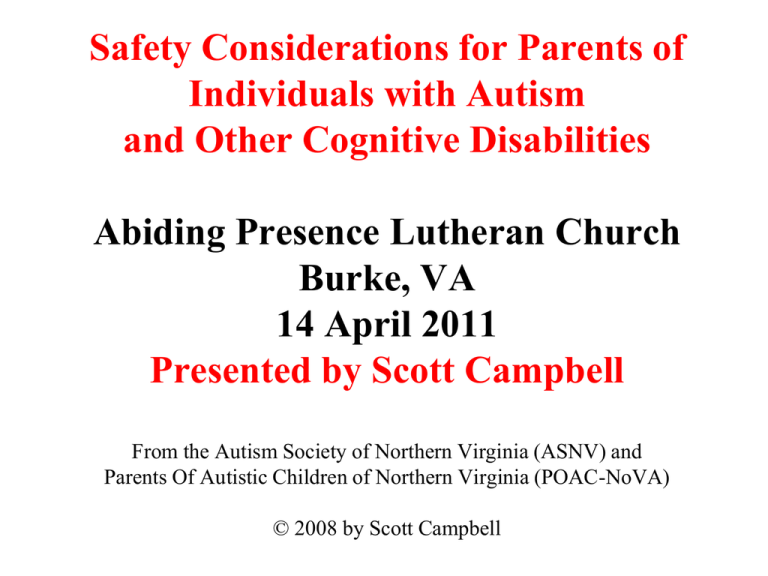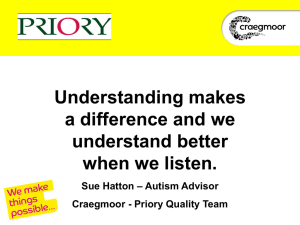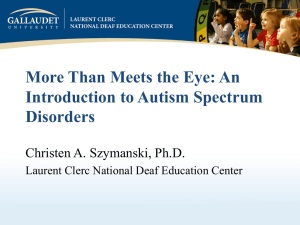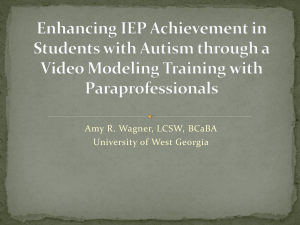
Safety Considerations for Parents of
Individuals with Autism
and Other Cognitive Disabilities
Abiding Presence Lutheran Church
Burke, VA
14 April 2011
Presented by Scott Campbell
From the Autism Society of Northern Virginia (ASNV) and
Parents Of Autistic Children of Northern Virginia (POAC-NoVA)
© 2008 by Scott Campbell
What are Autism Spectrum Disorders?
• Definition - Pervasive Developmental Disorders or
Autism Spectrum Disorders are developmental
disabilities that typically appear during the first
three years of life.
• Pervasive Developmental Disorders include Autism,
Asperger’s Syndrome, Rett’s Disorder, Childhood
Disintegrative Disorder (CDD), or Pervasive
Developmental Delay-Not Otherwise Specified
(PDD-NOS).
• Autism is a broad-spectrum neurological disorder that
causes the brain to process information differently.
• It is not a mental or psychological disorder.
• Autism impacts the normal development of the brain in
the areas of social interaction and communication
skills, along with some form of repetitive behaviors.
• Specific cause is unknown, & there is no definitive cure.
A Spectrum Condition
• Delayed speech is usually the first sign of a
possible development delay.
• Affects persons in varying degrees, severity
and symptoms.
• Independence levels vary.
• Individuals with autism spectrum disorders are
more like us than different.
• Each person with autism is unique.
• May display strength in some cognitive skills.
• Lasts their entire lives to some degree.
Incidence
•
•
•
•
•
•
•
•
•
•
No racial, ethnic, or social boundaries.
Income, lifestyle and education levels have no effect.
It is not caused by the way parents raise their children.
Affects about one half million Americans!
America’s fastest growing developmental disability at
1 in 91 to 112 children per reports from the Fall of 2009 using
data from 2006 on 8 year-olds.
[2,209 or 1 in 79 in FCPS for 2009, 940% growth since 1997]
{1 in 70 children of active-duty military families}
Four more prevalent for boys (1 in 58 to 70) than for girls!
New case is diagnosed about every 20 minutes. Over 70 a day!
Fastest growing developmental disability with 10-17% annual growth.
Costs $3.2M per person during their lifetime, or at least $35B per
year per Harvard School of Public Health Report, April 2006.
Having a child with autism affects the entire family!
Autism Risks
• May not know what to do or how to seek help.
• May not be able to communicate contact information,
what hurts, or what happened.
• May not react well in emergencies (re-enter burning home
or touch downed power lines).
• May not recognize real danger. Have NO real fear!
• May have very high tolerance for pain, heat and cold.
• May react poorly to changes in routine for apparent
trivial reasons.
• Will likely flail against physical restraint or continue to
struggle.
• May have other medical conditions, such as seizure
disorder (up to 30 to 40%), asthma, or hypotonia low muscle tone.
• Over 50% may be on a psychotropic medication.
Autism Risks, Continued
•
•
•
•
•
•
•
•
•
•
•
May not respond to stop or other commands.
May flee when approached due to sensory overload.
May inappropriately approach or run towards you.
May invade your personal space and have little eye
contact.
May repeat words or body language of law enforcement
officers. Often trained to be imitators!
May answer no or why to all questions.
May not recognize badge, uniform or marked vehicle or
understand what is expected of them if they do.
Behaviors draw attention and may limit credibility.
Elopement: lost and wandering.
Attracted to water, reflections, shiny objects, or high
places.
Some foods make the symptoms and behaviors worse.
Autism Risks, Continued
• Three times more likely to have to quit their jobs or reduce work
hours to care for their kids. They pay more for their kids'
health needs, spend more time providing for that care, and are
more likely to have money difficulties. (Kogan, 2008).
• Thought to be higher stress levels and divorce rates of 80-90%.
• Up to seven times more contacts with law enforcement. (Curry,
1993)
• Persons with disabilities over age 12 experienced violent crime at
rates that were two to three times that of persons without
disabilities for each violent crime measured. (DOJ, 2008)
• 50% more likely to experience nonfatal violent crime than those
without disabilities for those over age 12. (DOJ, 2007)
• Maltreatment of children with disabilities is 9.5 per 1000 for
physical abuse versus 4.5 for children without, and 3.5 per
1000 for sexual abuse versus 2.0. (Goldson, 2002)
• 64% of the children who were maltreated had a disability.
(Sullivan & Knutson, 1998)
Autism Risks, Continued
• “Approximately 61 percent of females and 25 percent of males
with developmental disabilities will be sexually molested by
age 18. Between 15,000 and 19,000 individuals with
developmental disabilities are raped each year in the United
States.” (Mitchell, 2006)
• “Children with intellectual disabilities were 4 times as likely as
children without disabilities to be sexually abused.” (Sullivan
& Knutson, 2000)
• Study found that the rate of sexual assault was 10.7 times higher
and 12.8 times higher for robbery for people with
developmental disabilities. (Wilson and Brewer, 1992)
• Another study found that 80% of victims of sexual assault with
disabilities had been assaulted more than once and 49% had
been sexually assaulted over 10 times. (Sobsey & Doe, 1991)
• Two studies found that 80% of women and 32 to 54% of men with
developmental disabilities had been sexually assaulted
compared to 13% of all women. (Hard, 1986)
• Multiple studies show that approximately 90% of individuals with
developmental disabilities know their abusers.
Wandering & Autism: the leading reason for
first response contact
• Often seek water sources (40% of deaths).
• Individual is in unsafe location.
• Running into traffic, enter homes of others, or looking
into windows of homes.
• Go with or run from strangers.
• May be seeking special treatment.
• Elopement prevention and care may look like abuse.
• Lack of ability to prevent elopement or self-injurious
behaviors may lead to criminal charges.
• Up to 50% non-verbal. (14% unable to talk by age
nine and 60% not able to speak fluently per
University of Michigan Study, 2004)
Other Common Reasons for First Response
– Medical emergency incidents or escalated behaviors at
home, retail setting, or schools.
– Person is acting out, and no one recognizes them.
– Person appears to be a threat due to suspected substance
abuse or obsessive/ compulsive behaviors.
– Parent or caregiver actions misinterpreted.
– Injury, incapacitation, or death due to accidental actions
of individual with autism.
– Medical emergency, fire or natural disaster - person is
alone and upset at scene.
– Self-imposed isolation may lead to lack of assistance
and resources.
• Get more info in Autism Society of America’s Safe and Sound Campaign at
http://www.autism-society.org/site/PageServer?pagename=research_safeandsound
• Recommend also enroll in the Alzheimer's Association’s Safe Return program
at www.alz.org/SafeReturn.
Project Lifesaver relies on proven radio technology and a
specially trained search and rescue team. Clients that are
enrolled in the Project Lifesaver program wear a personalized
wristband that emits a tracking signal. When caregivers notify
the local Project Lifesaver agency that the person is missing,
a search and rescue team responds to the wanderer's area
and starts searching with the mobile locater tracking system.
Search times have been reduced from hours and days to
minutes.
Project Lifesaver
• Rapid response program which places personalized radio transmitters
on persons who are at risk of wandering and getting lost, since
April 1999.
• 100% success rate with average location time of less than 30 minutes.
• As of 9 April 2011, have located 2,348 individuals in over
600 locales and 40 states.
• 54 million people in the U.S. now have Project Lifesaver coverage in
their area, equating to 18% of the U.S. population.
• 7 of the 41 largest cities in the U.S. now have coverage.
• 65% Project Lifesaver coverage in Virginia and 29% in Maryland.
• 95% located are Alzheimer’s adults and 5% are individuals with
autism or another developmental delay.
• Go to http://www.projectlifesaver.org for more info.
• Mechanical locks and audible alarms to keep person in the house.
• Dress the person in bright colored shirts & coats for a quicker search!
Cell Phone and Other GPS Options
• Verizon Wireless- Chaperone options.
Chaperone lets you easily locate your family members handset from your
Verizon Wireless phone or PC - in real time, at any time.
Chaperone with Child Zone lets you define a zone - specific area, such as a
school or summer camp. When your family member enters or leaves the
zone with their handset, Child Zone will automatically send an alert to your
phone with the time and location of your family member's handset.
• Cingular offers Firefly phones designed for kids with GPS built-in. More info is
at www.fireflymobile.com.
• Nextel Mobile Locator shows real-time location - see where people are either by
address or web-based map for $15/ month.
• Wherifone is another GPS locator phone option. More info is at
http://www.wherify.com/wherifone/kids.html?page=kids.
• Quantum Satellite Technology’s GPS sneakers should be available soon, but
will also require a $19.95 monthly subscription. More info is at
http://www.msnbc.msn.com/id/17063608.
• Jacket includes GPS tracker" dated 25 October 2007 on CNN.com at
http://www.cnn.com/2007/TECH/ptech/10/25/gps.jacket.ap/index.html.
GPS Options
• Care Trak tracking system service at http://www.caretrak.com/cths.htm.
• GPS track devices at http://www.diginetlink.com/Kids_Tracking_Devices_s/51.htm
• Lojack Safety net medical alert system service at
http://www.lojack.com/safetynet/Pages/index.aspx.
• PocketFinder, pocket-sized GPS device tracked through a PC or phone. More
info is at www.pocketfinder.com.
• Trackstick™ II Personal GPS Tracker at
http://www.earthgadgets.com/products/gps/trackstick/trackstick2/details.html.
• ionKids Child Locator or GemTrac GPS from Brickhouse Security at
http://www.brickhousesecurity.com/vbsik.html?engine=yahoo!4819&keyword=blu
espan costs $200 to $400 for a starter kit.
• Philips Lifeline System medical alert system service at http://www.lifelinesys.com.
• Rescue Alert medical alarm systems bracelets and medical alert system service at
http://www.rescuealert.com.
• FREE Safelink Wireless cell phone and service at
https://www.safelinkwireless.com/EnrollmentPublic/Home.aspx.
Autistic Child in Area Signs
• Traffic signs and signals are
maintained by the Virginia
Department of Transportation
(VDOT). For more information,
contact VDOT at 703 383-8368.
• From article titled "Sign of relief"
dated 17 March 2006 by Andy
Rathbun from The Battle Creek
(MI) Enquirer at
http://battlecreekenquirer.com/app
s/pbcs.dll/article?AID=/20060317
/LIFESTYLE08/603170302/1032.
• Another article titled “Rochester's
'Autistic Child' signs are among
the first in the nation" dated 27
February 2007 from The
Associated Press at
http://www.startribune.com/462/st
ory/1027629.html.
Sex Offender Registries
• http://www.nsopr.gov for the U.S. Department of Justice Dru
Sjodin National Sex Offender Public Website.
• http://www.mapsexoffenders.com for nationwide sex offender
mapping and information.
• http://www.familywatchdog.us for another sex offender registry
and information.
• http://www.fbi.gov/hq/cid/cac/states.htm for the FBI’s list of State
Sex Offender Registry Web Sites.
• http://www.ice.gov/pi/predator/sexoffenders.htm for the U.S.
Immigration and Customs Enforcement (ICE) sexual offender
information by state.
• http://sex-offender.vsp.virginia.gov/sor for the Virginia State Police
Sex Offender and Crimes Against Minors Registry.
• http://www.dpscs.state.md.us/onlineservs/sor for the Maryland
Department of Public Safety and Correction Services’ Sex Offender
Registry.
• http://mpdc.dc.gov/mpdc/cwp/view,a,1241,q,540704,mpdcNavGID,1523,mpdcNav,1%20,.asp for the DC Metropolitan Police
Department’s Sex Offender Registry.
Why Proactive Involvement
• “A preliminary assessment of police officers’ knowledge and
perceptions of persons with disabilities" by Modell, S.J. & Mak,
S. at http://icad.wordpress.com/2008/08/19/police-officersdisability.
• Survey of 124 police officers of various ranks in Northern
California:
• 56% did not know the difference between mental and physical
disabilities.
• 80% were unable to describe characteristics of autism.
• 48% indicated that they had received no training on disabilities,
and an additional 45% indicated that they had minimal
training.
• Finally, 63% of officers indicated that they would like to receive
more training on people with disabilities and how to work
with them.
How to Do Community Involvement
• Get your neighbors and community involved proactively.
• Ask neighbors to call you immediately if they see your child outside
the home; before calling 911.
• Provide 911 information sheets with photo and your contact info to
neighbors; explain unusual behaviors.
– Have a get-to-know-your-kid BBQ or party, so they know you
are approachable.
– Show them your child’s ID wear, tags, or info cards.
– Inform neighborhood watch programs.
• Get “Unlocking Autism” license plates. Tackle box!
• Visit your local police and fire departments.
• Get a “Kidsmart Vocal Smoke Detector”, if needed.
• In 911 situation, ask to ride with your child.
• Amber Alert info is at http://www.amberalert.gov and ask about
them in stores you go to frequently.
• Parking placards for Virginians with disabilities application at
http://www.dmv.state.va.us/webdoc/citizen/disability/plates_ass
ist.asp and “Walker” or “Non-Driving ID” from DMV.
911 Flags for Local Dispatcher
• 911 flags with key dispatch data to alert first responders as a
“location of interest”.
• Information sheets at 911 data base with name, address, phone
numbers and emergency contacts, including:
• Name of individual with autism.
• Current photograph and physical description including height,
weight, eye and hair color, any scars or other identifying
marks.
• Names, home, cell and pager phone numbers and addresses of
parents or caregivers and emergency contact persons.
• Sensory, medical, or dietary issues, if any.
• Inclination for elopement and any atypical behaviors or
characteristics that may attract attention.
• Favorite attractions and locations where person may be found.
911 Flags for Local Dispatcher, Continued
• Likes, dislikes--approach and de-escalation techniques.
• Method of communication, if non-verbal sign language or
picture boards.
• Identification wear jewelry, tags, info cards, or in their clothes.
• Map and address guide to nearby properties with water sources
and dangerous locations highlighted.
• Blueprint or drawing of home, with bedroom of individual
highlighted.
(From Autism, Advocates and Law Enforcement Professionals,
Dennis Debbaudt, 2003)
• Fairfax County Medical Needs Registry Form at
http://www.fairfaxcounty.gov/specialneeds/medicalneedsregistry.h
tm.
Sources for Autism Awareness Items
• “Basic Information About Autism To Carry In The Pocket” Pocket
Slip at http://hasselbrink.com/Pocketslip1.doc and
http://hasselbrink.com/Pocketslip2a.doc.
• “Contact and Emergency Information To Be Carried In The
Pocket” Pocket Slip at http://hasselbrink.com/Pocketslip2a.doc.
• “Information for Neighbors” Pocket Slip at
http://hasselbrink.com/Neighbors.doc.
• Law Enforcement Awareness Network On Us personal autism safety
cards for children at
http://www.leanonus.org/images/LEAN_On_Us_Child_ID_Safety_
Card_7_04.pdf and for adults at
http://www.leanonus.org/images/LEAN_On_Us_safety_card_for_ad
ults_7_04.pdf.
• Silent No More Premise Alert Form and Information at
http://www.papremisealert.com.
Sources for Autism Awareness Items
• http://www.911life.com sells an assortment of medical and alert
cards, bracelets, shoe tags and necklaces.
• http://ecpdefense.mybisi.com/product/69207/Child-GuardWireless-Alarm_293487.html for Child Guard Wireless Alarms.
• http://www.asaphilly.org sells emergency alert decals.
• http://www.autismlink.com/store sells “child with autism” safety
tags, cards, bracelets, decals, lanyards and shirts.
• http://www.autismva.org to buy autism awareness window cling,
please contact Didi Zaryczny at dzaryczny947@cs.com.
• http://www.buttonsandmore.com sells a large number of autism
awareness and safety/ ID cards, decals and magnets.
• Dennis Debbaudt’s 911 Handout - http://www.poacnova.org/pdfs/Debbaudt 911 Handout.doc -- Sample Handout for
Ian Campbell - Ian Campbell's Sample 911 Handout.doc.
• POAC-NoVA personal autism safety cards at http://www.poacnova.org/pdfs/Autism Cards from POAC-NoVA.pdf.
• http://kidcallcard.com for a card with up to 10 phone numbers.
• http://www.911life.com sells an assortment of medical and alert
cards, bracelets, shoe tags and necklaces.
Sources for Autism Awareness Items
• Allergy labels at http://www.labelsthatlast.com/allergy_labels.asp.
• USB devices on wrist bands at http://www.carememoryband.com.
• Iron-on cloth labels at http://www.child-identificationproducts.com/child-iron-on-name-tag.html.
• Medic Alert sells bracelets & medallions at http://www.medicalert.org
• http://www.medicalmedallion.com sells a recorder that carries up to
80 words of the person’s vital medical or other information.
• Guide to Good Care sells USB devices with a digital memory chip
at http://www.gcpublishers.com/Catalog.aspx?ProductId=1.
• Medic Tag also sells USB devices at http://www.medictag.com.
• http://www.mypreciouskid.com/ID-shoes-tags.html for a wide
assortment of child identification items.
• https://shopping.webformix.net/lifeline/child.htm for ID bracelets.
• Autism youth-size bracelets at www.stitches4autism.com.
• Temporary tattoos at http://tattooswithapurpose.com.
• http://www.unlockingautism.org sells autism awareness stickers too,
but they are made of paper and do not last very well.
Examples of Autism Awareness Items
Examples of Autism Awareness Items
Students with autism need education to help
them respond well during an emergency
• How to call for help and safely show identification and
•
•
•
•
•
•
info cards.
How to recognize and respond to first responders as a safe
“go-to” stranger.
How to go to safe places and persons.
Reduce fear of uniform, badge and police vehicles.
How to interact with law enforcement officers (next
slide).
Recognize inappropriate touching or sexual come-ons.
How to report bullying, teasing and taunting incidents.
Students with autism need education to react
safely in law enforcement encounters
•
•
•
•
•
•
•
•
•
Do not attempt to flee.
Do not make sudden movements.
Keep appropriate distance when interacting with police.
Try to remain calm.
Tell, sign, or write officer that person has autism.
Get prior permission before reaching in pocket or a car glove box.
Show medical alert bracelet or necklace, or id and info cards.
Carry phone numbers of autism advocacy organizations.
When to invoke the right to remain silent and ask to speak to an
attorney.
• Ask officer to contact a family member or advocate, if necessary
and possible. Particularly before the interview process.
• Use the Arc’s Justice Advocacy Guide at
http://www.thearc.org/page.aspx?pid=1646.
Safety Training Resources
•
•
•
•
•
•
•
Electrical and traffic safety training resources at
http://www.johnbald.net/goplay/safety.htm.
Autism and Safety - how to be prepared suggestions at
http://www.tacanow.com/autismsafety.htm.
Safety in the Home hints at http://www.autismsociety.org/site/PageServer?pagename=livingsafety.
Emergency situations training resources at
http://www.frsd.k12.nj.us/autistic/Emergency%20Situations/Sto
ries/emergency_situations.htm.
http://www.cec.sped.org/osep/database/detailView.html?masterID=
387 explains the “Safe Life” program.
Do2Learn has some good lessons about street safety at
http://www.do2learn.com/games/songs/streetsafety/index.htm.
Autism & Airport Travel Safety Tips at
http://www.sath.org/?section=Travel%20Tips%20and%20Acce
ss%20Information&id=2371&skip=.
Safety Training Resources
•
•
•
•
•
•
“Victimization & Abuse of Persons with Autism” article at
http://www.autismmi.org/Protecting%20Loved%20Ones%20with%20Autism.pdf.
"Tips for Keeping Children on the Autism Spectrum Safe" article at
http://www.bellaonline.com/articles/art40928.asp
Protecting the Child or Adult with Autism Information for Parents
and Other Caregivers article at
http://www.scautism.org/protect.html.
Autism Proof Your Home- Making A Secure Environment
suggestions at
http://autism.about.com/cs/familyissues/a/safety.htm.
Fire Safety for Autistic Children hints at
http://autism.about.com/cs/parentstrategies/a/firesafety.htm.
Child Abduction and Autism- The Unique Problems of ASD
concerns and suggested recommendations at
http://autism.about.com/cs/hiddenproblems/l/blabduction.htm
Transportation Security Administration Guidance
• Guidance for persons with disabilities and medical conditions at
http://www.tsa.gov/travelers/airtravel/specialneeds/index.shtm.
* Inform the screener if someone has any special needs or medical
devices.
* Inform the screener if you think someone may become upset
during the screening process as a result of their disability.
* Offer suggestions on how to best accomplish the screening to
minimize an outburst for the child.
* Ask the screener for assistance during the process by helping you
put your and the child's carry-on items on the x-ray belt.
* Know that at no time during the screening process will they be
separated from the child.
* Tell the screener what are the childs' abilities are.
* Know that if a private screening is required, you should escort
and remain with the child during the private screening process.
Transportation Security Administration Guidance
* Know that all no time should the screener remove the child from
his wheelchair. You are responsible from removing the child
from his equipment at your discretion to accomplish screening.
* Know that if your child is unable to walk or stand, the screener
will conduct a pat-down search of your child while he/she
remains in their mobility aid, as well as a visual and physical
inspection of the equipment.
• Printable TSA Medical Notification Card is at
http://quest.mda.org/sites/default/files/Notification%20Cards%20II.pdf
• TSA Requirements for Travelers with Disabilities and Medical
Conditions is at
http://www.tsa.gov/travelers/airtravel/specialneeds/index.shtm.
• Department of Transportation Information for the Air Traveler with a
Disability at http://airconsumer.ost.dot.gov/publications/horizons.htm.
• Department of Transportation Information on Nondiscrimination on
the Basis of Disability in Air Travel at
http://airconsumer.ost.dot.gov/rules/rules.htm.
Emergency Preparedness Resources
• http://www.ready.gov from the U.S. Department of Homeland
Security.
• http://www.hhs.gov/od/emergencypreparedness.html from the
Department of Health and Human Services.
• http://www.makeaplana.org from the National Capital Region.
• http://www.nod.org from the National Organization on Disability.
They have a “Prepare Yourself: Disaster Readiness Tips for
People with Developmental or Cognitive Disabilities” available.
• http://www.disabilitypreparedness.org from the National Center on
Disaster Readiness Tips for People with Developmental or
Cognitive Disabilities.
• http://www.autismsociety.org/site/DocServer/disaster_tips.pdf?docID=2881 from the
Autism Society of America for disaster tips.
Emergency Preparedness Resources
• Autism Risk & Safety- Are You Prepared for an Autism Emergency? by Dennis
•
•
•
•
•
Debbaudt at http://www.autismriskmanagement.com/id1.html.
http://www.cdihp.org/links.html#disaster and
http://www.cdihp.org/products.html#evac_guide from the Center for
Disability Issues in the Health Professions and June Isaacson Kailes for
resources in English and Spanish.
http://www.cshcn.org/resources/careplans.cfm from the Children's Hospital and
Regional Medical Center for Care Plans and Forms for Your Child with
Special Needs in English and Spanish.
http://www.fema.gov/library/disprepf.shtm from the Federal Emergency
Management Agency.
http://www.gmu.edu/accessibility/test/ep.html from George Mason University.
http://www.redcross.org/services/disaster/beprepared/disability.html from the
Red Cross.
For more information, contact:
Scott Campbell
703 241-2640 (Home)
scott.alan.campbell@us.army.mil
Autism Awareness and Home Safety web links at
http://www.poacnova.org/base.cgim?template=autism_awareness








